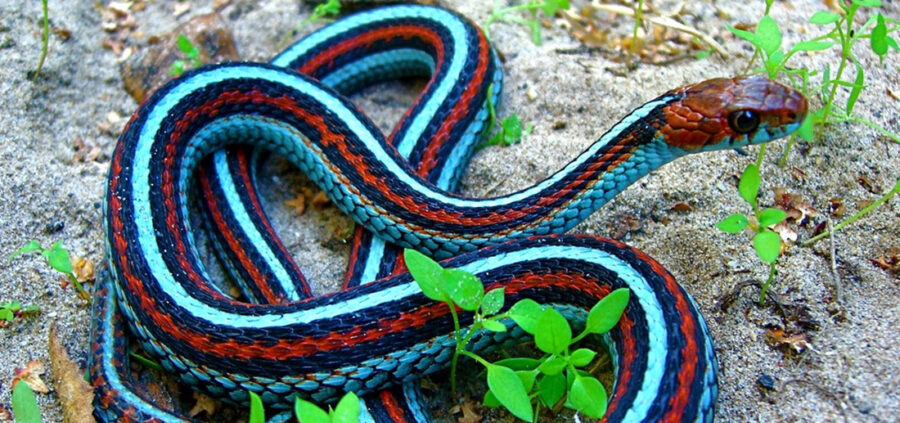
The beautiful San Francisco garter snake can be seen in the western parts of the San Francisco peninsula, around hillsides from the San Fran. city line on south to the Crystal Springs Reservoir, and along the coast to the Año Nuevo State Nature Reserve. They prefer thick vegetation surrounding ponds and wetlands with close open hillsides. These snakes are listed as Endangered by the IUCN. This is due primarily to habitat destruction and over-collecting for the pet trade.
First the Stats…
Scientific name: Thamnophis sirtalis tetrataenia
Weight: Up to 8 ounces
Length: Up to 51 inches
Lifespan: Up to 15 years
Now on to the Facts!
1.) These snakes are primarily diurnal (active during the day) but have been observed hunting at night (nocturnal).
2.) This garter snake, like many others, eats newts, frogs, toads, and small fish.
3.) They are one of the few animals who are able to eat the toxic California newt and survive to tell the… tail (pun intended).
4.) Adult snakes will often estivate (enter a dormant state – like hibernation) in rodent burrows during summer months when ponds dry out. Along the coast, some will brumate (a reptile’s version of hibernation) during the winter, but going further inland, if the weather is acceptable, some of these snakes can be active year round.
5.) Hawks and herons, as well as other snakes, prey on these garter snakes. Domestic cats, bullfrogs, and other small mammals also look to feast upon their colorful personages.
But wait, there’s more on the San Francisco garter snake!
6.) Illegal collection, as well as loss of habitat from agricultural, commercial, and urban development has led to a decline in their numbers.
7.) There are only approximately 6 known populations of this garter snake remaining in the wild, and at least 4 of these groups have reduced in recent years.
Did you know…?
It’s estimated that there may be only 1,000 – 2,000 San Francisco garter snakes remaining in the wild today!
8.) Females give live birth from June – September. Their clutches yield an average of 16 baby snakes.
9.) The San Francisco garter snake is a subspecies of the common garter snake.
10.) Due to their beautiful colors and mild disposition, these snakes are often over-collected for the pet trade.
Now a Short San Francisco Garter Snake Video!
Also, check out the Critter Science YouTube channel. Videos added frequently!
Want to suggest a critter for me to write about? Let me know here.



